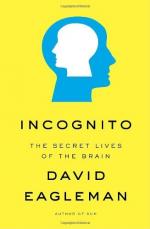
|
| Name: _________________________ | Period: ___________________ |
This test consists of 5 short answer questions, 10 short essay questions, and 1 (of 3) essay topics.
Short Answer Questions
1. What does Alberts record?
2. What does Eagleman say about the ability to sort?
3. What does the device that takes visual input through a camera and translate it into impulses do?
4. What does the author say lies underneath one's exterior looks?
5. How does May first react to his new sight?
Short Essay Questions
1. What does Eagleman say about how vision works?
2. What is another illustration of how one reacts to something before the person is even aware of the situation?
3. What ways can our vision be fooled?
4. What is one way to measure how our unconscious minds affect our conscious thinking without our even knowing it?
5. Why does Eagleman say it is not correct to change lanes by turning the wheel right and then straightening it out?
6. What is the point of the experiment that Eagleman suggests the reader try?
7. What does Eagleman say the experiment with the photographs of women illustrates?
8. What gap does Eagleman explore in Chapter 3?
9. What does Eagleman say about the auditory sense?
10. What is one example Eagleman gives of how one reacts to something before the person is even aware of the situation?
Essay Topics
Write an essay for ONE of the following topics:
Essay Topic 1
This assembly of competing routines is what makes up most of the activity of our brains, and our conscious mind, as is demonstrated in brains where these competing processes have been interrupted or disconnected, is mostly at the mercy of our unconscious processes. Eagleman presents the results of experiments that suggest that our conscious mind will even fabricate reasons for our actions after the fact when we cannot tell what our true motivations are.
1. There is a saying that we do not really look at pros and cons for a decision but instead make the decision unconsciously and then justify our decision with pros and cons. Discuss this idea bringing in the examples Eagleman gives.
2. Do you think most of the time a person does not know his or her true motivations for behavior? Why or why not? Use examples from your own life and Incognito to support your reasoning.
3. Discuss an incident in your life where after it happen you could not understand why you said or did what you said or did. How does that incident relate to Eagleman's assertion about unconscious control of people's lives? Use examples from your own life and Incognito to support your reasoning.
Essay Topic 2
Eagleman in writing about Mel Gibson cites anti-Semitism was demonstrated by Gibson. Discuss one of the following:
1. Define anti-Semitism and give examples of it from both Incognito and other sources.
2. Do you think anti-Semitism still exists in the United States? Explain.
3. Discuss the idea put forth by Eagleman that Mel Gibson may have two brains, one not prejudice and one that is. Use examples from Incognito to support your answer.
Essay Topic 3
Incognito belongs to the non-fiction genre. Discuss the following:
1. Define the literary term "genre" and give several examples of three other genres in addition to the non-fiction genre.
2. Discuss two reasons why it might be useful to label a text by genre and two reasons it might be disadvantageous to label a text by genre.
3. What do you think is the difference between a nonfiction book and a novel?
|
This section contains 1,102 words (approx. 4 pages at 300 words per page) |

|




